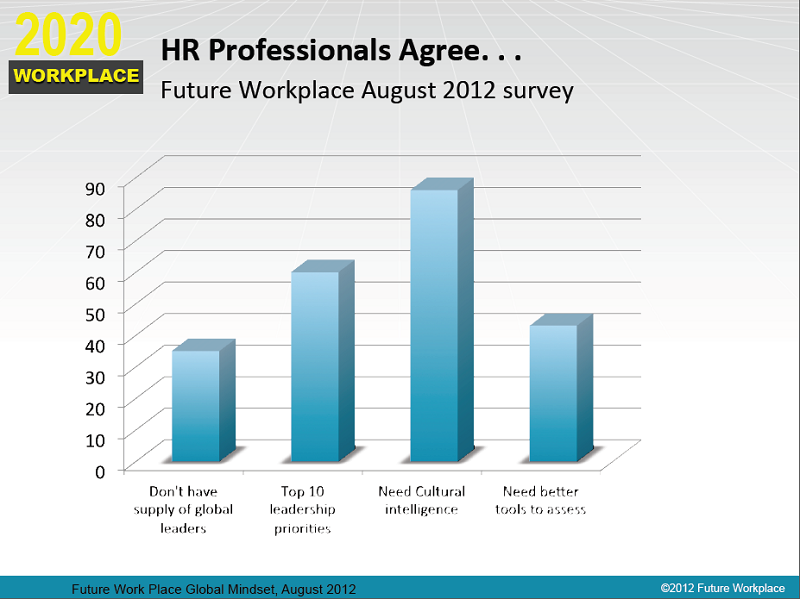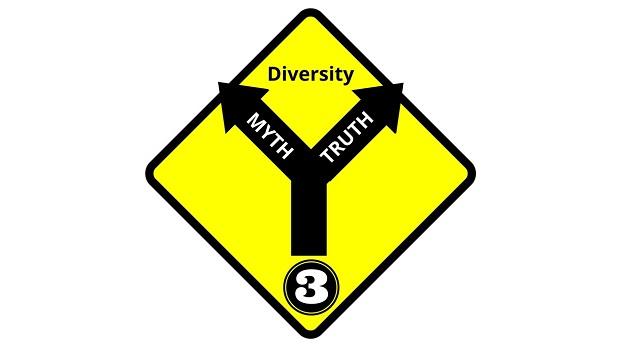 Every report that predicts future workforce skills names cultural competence as a key one necessary to navigate our hyper-connected, globalized world. Whether your duties are primarily domestic or you have global responsibilities, the ability to effectively navigate in different cultural contexts and to share meaning across cultures is paramount. It is no longer enough to be aware and sensitive of differences, leaders and individual contributors who are increasingly working across borders need to have the skills and abilities to bridge cultural differences for successful business results.
Every report that predicts future workforce skills names cultural competence as a key one necessary to navigate our hyper-connected, globalized world. Whether your duties are primarily domestic or you have global responsibilities, the ability to effectively navigate in different cultural contexts and to share meaning across cultures is paramount. It is no longer enough to be aware and sensitive of differences, leaders and individual contributors who are increasingly working across borders need to have the skills and abilities to bridge cultural differences for successful business results.
Most early D&I work had a US focus. That is certainly not the case anymore (See “Diversity” Gone Global). Diversity and inclusion concepts are being embraced on a global scale as evidenced by the number of CDO positions springing up in Europe and parts of Asia. There has also been a steady increase in the number of D&I focused conferences that are conducted in various parts of the world. Globalization is the major reason for this trend.
In the book The 2020 Workplace by Jeanne C. Meister and Karie Willyerd, published by Society of Human Resource Management (SHRM), the authors name three forces impacting the future workplace including social media, generations and globalization. Fifty-nine percent of CEO’s in a survey conducted by PriceWaterhouseCoopers said that emerging markets are more important to their success than developed ones because these newer economies are poised to outpace the GDP of developed markets creating new access to capital and talent. As a result, many US based Fortune 100 companies have more than 50% of their employee base situated outside the United States. Additionally, companies are choosing to move headquarters operations to different countries to take advantage of more favorable business climates. The blurring of strict “national” boundaries makes it imperative for D&I professionals to understand how diversity issues manifest around the globe.
What is Cultural Competence?
The term cultural competence has been used in education and health care for some time. It is a fairly new idea in the business world. Some scholars use the term intercultural competence, while others call it cross-cultural competence and the authors of The 2020 Workplace uses the term global mindset, defined as the ability to understand how to conduct business with people, organizations and teams that are unlike ourselves. Cultural competence has been defined many ways. One definition that The Winters Group has adapted is:
A continuous learning process to develop knowledge, appreciation, acceptance and skills to be able to discern cultural patterns in your own and other cultures and be able to effectively incorporate several different world views into problem solving, decision making and conflict resolution.
Future Workforce Skills 2020, a study conducted by The Institute for the Future for the University of Phoenix Research Institute names 10 skills critical for the future based on six drivers of change. One of the drivers of change is “globally connected world” which “puts diversity and adaptability at the center of organizational operations.” The report names cross cultural competence as one of the key future skills.
“Diversity will therefore become a core competency for organizations over the next decade. Successful employees within these diverse teams need to be able to identify and communicate points of connection (shared goals, priorities, values) that transcend their differences and enable them to build relationships and to work together effectively.”
Leaders Lack Cultural Competence
While it is widely recognized that cultural competence is a critical skill for the future, HR leaders agree that there is a gap. According to a Future Workplace survey conducted among HR leaders, leaders need cultural intelligence, yet another term used to define cultural competence.

Most current diversity and inclusion training falls short in developing skills and abilities needed to navigate across cultures. It is typically conducted as a one-time 2-4 hour session with little follow up or opportunity to practice new skills. At best, such training is little more than a briefing that raises awareness.
According to a study just released by The British Council Called Culture at Work, just over a third of global employers are satisfied with the cross cultural skills education provided by their respective educational systems.
Leaders in cross-cultural education sessions conducted by The Winters Group often admit to being deficient in effectively working across cultures. One leader for a fortune 100 company said that he was working on a merger with a European company where all sorts of cross cultural misunderstandings were slowing the progress. After attending one of four sessions that the leadership team would experience, he clearly saw the need to offer similar learning to the team working on the merger. According to a study conducted by McKinsey and Company, 70% of leaders surveyed after a merger said that too little effort had been spent on understanding the corporate culture of the other company. The recent survey conducted by Chuck Shelton found that there were wide gaps in the perceptions of women and people of color and White men as to the ability of leaders to coach across cultural differences. The author concluded that the divide was due to lack of authentic dialogue. I conclude that the lack of dialogue is due to a lack of cultural competence.
Implications and Recommendation for D&I Practitioners:
- We have to do a better job of educating leaders and individual contributors to be culturally competent. A few hours of training is insufficient. Learning needs to be developmental and ongoing. It should be robust and follow adult learning theory.
- The same type of investment that companies have given to transformational efforts such as six sigma need to be applied to developing cultural competence. (See A Point of View: A Wish: D&I Becomes the Next Six Sigma)
- Leaders do not yet see the need for such major investment in this type of learning because many have the mindset that cultural differences are not that significant. We are all human. Cultural differences within one’s own country as well as from country to country are often subtle and nuanced and can have a huge positive or negative impact on the bottom line. Companies lose millions in productivity as a result of ineffective mergers, advertising blunders and law- suits. Companies also increase profit when they effectively address issues of difference, leveraging them to be gain competitive advantage through increased innovation.


















